How Trae Young Is Transforming Oklahoma While Doing the Unprecedented

When I introduce myself to Trae Young, he introduces himself to me too. That is the second surprise of the afternoon. The first is watching Oklahoma practice for an hour and seeing Young play so routinely and unassumingly, operating solely within the confines of what can be planned and rehearsed. This is not a sight college hoops fans have grown accustomed to during Young's off-the-charts freshman season, which can be measured as much by his outlier statistics as by his outlier means of compiling them. During practice he simply blends in. Then he jogs off the court and stops to shake my hand. "Trae Young," he says. "Nice to meet you."
An hour later, after showering and attending a team film session, Young emerges for some additional video study. He is wearing gray Nike sweats and a white Lil Uzi Vert concert T-shirt, his facial hair wispy and his 6'2", 180-pound frame wiry, generally looking like the 19-year-old he is. He takes a seat at a row of desks used by courtside media in the Lloyd Noble Center and eyes my laptop, which has clips from the scouting service Synergy Sports Technology. The idea is for him to narrate some of his most outrageous plays, to explain to average human beings how he does what he does. He nods like a point guard receiving instruction in a huddle. He is game.
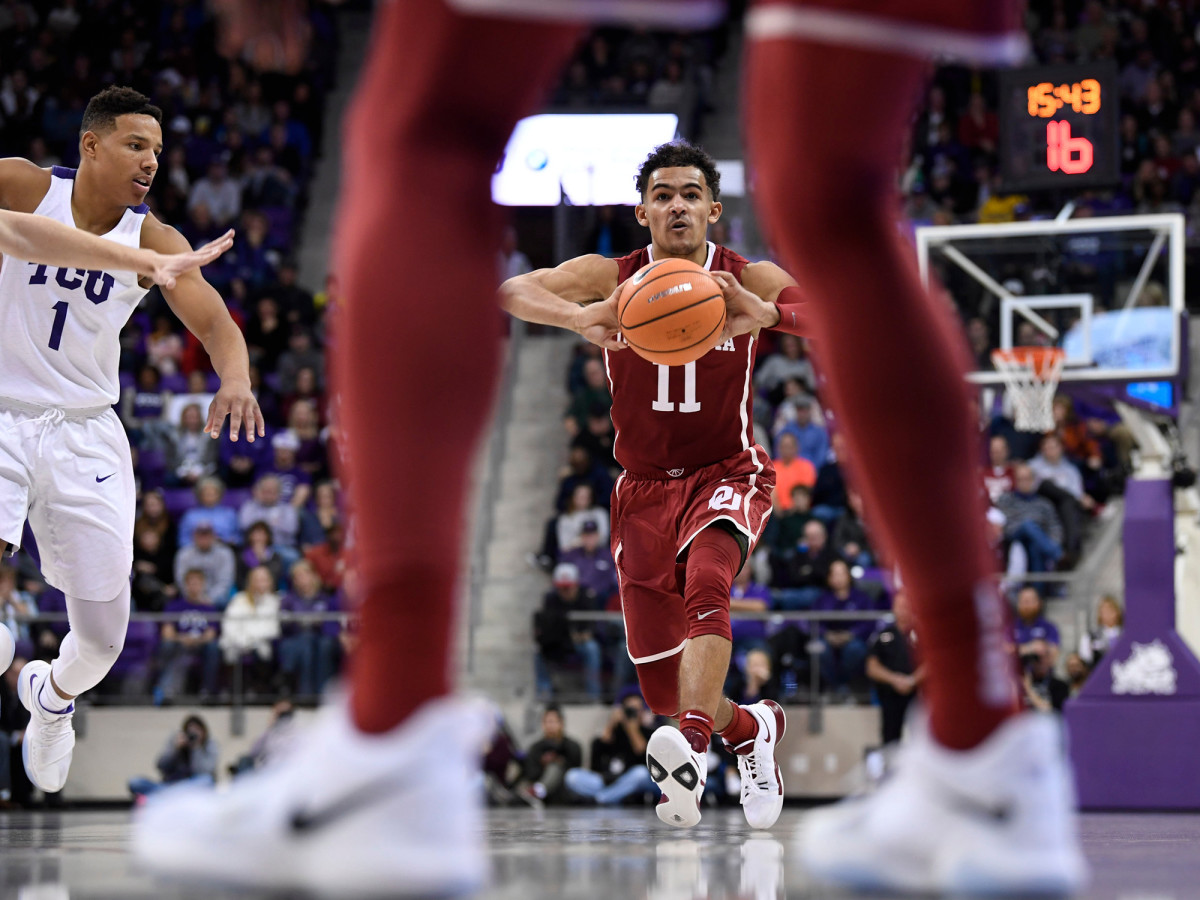
The Trae Young Show, on the screen in front of us, has been a spectacle with highlight after highlight, many punctuated by an announcer's "Oh, my" or "Come on." My standard for inclusion in this compilation, from his first 14 games, was any basket or pass that made me think, Wow. That initially resulted in a selection of 109—almost eight per game!—that I whittled to 64. Among them are step-back threes from NBA range with only a sliver of room, hair-trigger pull-ups from even farther, absurd full-speed floaters released over defenders who haven't yet realized he's even raised the ball to shoot. That every one of the shots went in (only makes were included) never stopped me from wondering how the next one could.
As of Feb. 1, Young was on pace to lead the country in points (30.3) and assists (9.5), a feat previously accomplished by no one. And lest you think he's a ball hog (for using 40.2% of the Sooners' possessions, the highest rate in the country), his team, which has nine holdovers from last season's 11--20 roster, is 16--5 and has been ranked as high as No. 4.
Young, a five-star prospect once presumed to be too undersized for the NBA fast track, has rocketed from the fringes of mock drafts to flirting with the top five. But in an era of one-and-done freshmen he is the rare here-and-now commodity; the attention he's being paid is less about what he might one day accomplish in the NBA than what he's doing and daring to do each week. Even his sport's giants have taken notice. Steph Curry—who, as a junior at Davidson in 2008--09, had perhaps the most similar college season and to whom every brilliant and smallish shooter-passer is now compared—has called Young "unbelievable" and lauded his "magnetism." Reigning MVP Russell Westbrook has said Young is doing "an amazing job." LeBron James posted three unsolicited Instagram photos of the two of them together at a Nike camp. Last month a question about Young inspired John Calipari, who recruited Young aggressively, to channel Yogi Berra: "I knew how good he was," he said, "but I didn't even realize he was this good."
Even more surprising is how well Young appears to be handling it all, how he has not been crushed by increasingly weighty expectations or suffered some kind of cranial combustion from the plaudits offered by the biggest stars in the hoops world. It's another thing I'll ask him about, but first we are going to watch some basketball.
Young wastes no time seizing the laptop's controls, figuring out quickly that the keyboard's spacebar stops and starts the video and its up and down keys toggle between clips. (Rewind and fast-forward prove a little trickier, but he gets it.) At one point, during a clip where he splits two TCU defenders in transition with a hard dribble and then scores on a scoop shot in front of a third, I ask how he would describe what he's processing on the court.
"I'm thinking ahead, what I'm about to do, and envisioning all different types of stuff," he says. "And I slow down and I know if I do this, I know what's gonna happen after I make the move. I just know." Ah, yes. Simple as that.
The first time the Young family met with Oklahoma's NCAA compliance office, Trae was asked how he knew Lil Wayne. He told the truth: He didn't know Lil Wayne. So the compliance officer pulled up a photo from a Lil Wayne concert, and there was Trae, dapping up Weezy F. Baby himself. Trae said he was called onstage at a show in Oklahoma City because Wayne is a big basketball fan and Trae was someone a big basketball fan would know, and he went up because, why not? The compliance officer asked if Trae knew Lil Wayne owns a sports agency.
These are problems that present themselves when you're Trae Young. Trae's dad, Rayford, shares this story in his family's living room in Norman, where they've lived for the past decade; a 10-minute drive from Oklahoma's campus. It came up because I'd asked about the hoodie Rayford is wearing, a black number with an interlocking white TY on the chest that looks not unlike a symbol used by the pro wrestler the Undertaker. He and his wife, Candice, explain that they'd had the hoodies, as well as some T-shirts, made last year by a friend in town who owns a print shop, thinking they'd give them to people they knew and maybe sell a few. But the compliance office reminded them that, NCAA rules being what they are, Young can't profit from his likeness. (On the bright side, when he does go pro and signs a branding deal, at least they've already got the logo.)
In many ways Rayford, an account manager for a medical devices company, has been readying Trae for the NBA since birth. Trae was born when Rayford was a junior guard on Texas Tech's basketball team—Candice, Rayford's high school sweetheart, was a sophomore at the school—and there was little doubt that his son, like Rayford's father (who played juco ball) and his uncle (who played NAIA), would be a basketball player too. Candice and their first two children, Trae and Caitlyn, tagged along to Rayford's pro stints in France, Italy, Portugal and Spain, eventually settling in Norman to be near Candice's family. (Daughter Camryn and son Timothy were born after the family moved back to the States.) But Rayford knew there was tougher competition in Texas, and so as early as grade school he would ferry Trae three hours to Dallas or six hours to Houston. "This is what it's all about," Rayford would tell him. "Do you wanna just stay in Norman and play with all your friends, or do you really wanna be one of the best?"
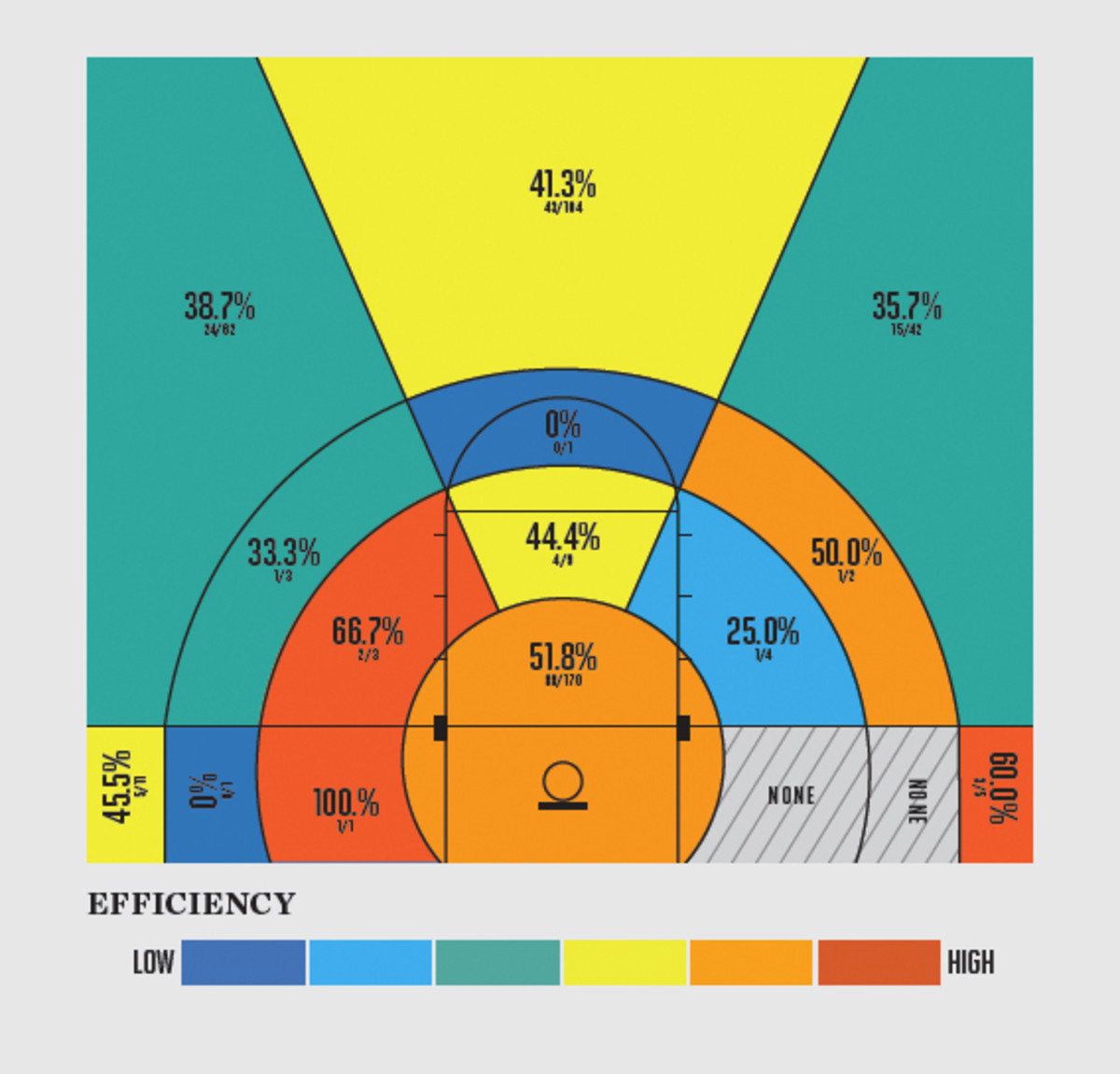
That also meant ample work at home and, yes, film study—of Kyrie Irving's predraft workouts, of Warriors games, of DVDs spliced by Rayford's friends who populated NBA staffs. Father and son would arrive hours early to Thunder games (Rayford has had season tickets since the team moved to Oklahoma City in 2008) and scour players' pregame routines for bits Trae could mimic. Friday nights meant cone drills at a nearby junior high. School days would begin at 6 a.m. at the YMCA, and then resume there in the afternoon, where father would hold a broom above his head so that son could hone a floater inspired by Steve Nash. "You've got three courts, parents just joking around shooting with their kids," Rayford recalls. "Then you see this military dad with the broom. Come on! Get it over the broom!"
Results were swift. At Norman North High, Trae started on varsity as a freshman; the next year he averaged 24.0 points. By his senior season he was averaging 42.8, once scoring 62 in a 32-minute game in which he sat out nearly a quarter. On the court he drew constant double teams, often breaking them by pushing the ball between defenders' legs. Off it, things grew so frenzied with postgame selfie-seekers that the team assigned an assistant coach to act as his bodyguard. He was barely 16 when he uh and um'd way through his first sit-down TV interview, in his family's living room. In his junior year the state's largest newspaper published a schedule under the headline: WHERE TO SEE NORMAN NORTH'S TRAE YOUNG IN ACTION. By the next year the bleachers at the school's practices would be so cluttered with major college coaches that North's coach, Bryan Merritt, would joke it looked like an industry reunion.
Rayford had been through this process himself, and in some ways choosing Texas Tech had been great, because he scored a ton of points there (1,525). But in other ways it was not, because his team floundered around .500 and he never made the NCAA tournament. He implored Trae to choose Kentucky, to play for a coach who got his players to the NBA and his teams to college's biggest stage. Candice favored Kansas, a blue blood closer to home. But Trae was partial to Oklahoma, where he'd gotten to know the players through pickup games and where he could still see his family for dinner. The Youngs had raised a son who believed anything he could do, he could do anywhere.
A minute or two into our video session, after he's stopped and started several clips to provide analysis, he suddenly perks up. On screen is the first clip from his game against TCU on Dec. 30, in which he had 39 points and 14 assists. "Oh," he says. "This is one of my good games." Which, sure. But at this point his worst game had been one in which he scored 29 points in a loss at West Virginia, albeit on 8 for 22 shooting. If he's kidding, he's got an All-America poker face.
Young's not easily impressed by himself, but there are times when he is caught off-guard. Watching one outlandish floater against TCU, in which he dribbles past two defenders in transition before arcing a shot over two more, he abandons any attempt at insight. "I don't know why I did that," he says, smiling. Another time, seeing himself hurl a particularly ambitious three from 28 feet against West Virginia, he says, "This is where I look at it and I'm like, Oh, my, why am I shooting that deep? But in a game I just have a feel of where I'm at. And if I'm in range, I'll just shoot it from wherever."
Earlier in that game, doubled off a high ball screen from teammate Jamuni McNeace, Young found himself briefly trapped on the right wing. "See all these people helping?" Young asks, alluding to the two additional defenders tracking him, making it a swarm of four. He pauses the clip and points to a pair of teammates. "So I know I have either him"—Brady Manek, open at the top of the arc—"or him"—Kameron McGusty, alone on the opposite wing. The clip resumes, showing Young whip a pass to McGusty, who buries a catch-and-shoot three.
It's Young's passing that has most surprised observers. He averaged just 5.0 assists in high school but now regularly (and ambidextrously) threads needles on long-distance and off-kilter passes to, as ESPN's Fran Fraschilla puts it, "teammates who didn't even know they were open." Only four players in the last 20 years have topped his average of 9.5 assists; he had 22 in a single game, against Northwestern State on Dec. 19. Was that something he consciously worked to improve? "It's just the perception," Young says. "This is how I've always played."
This same assuredness is on display when he watches a step-back off the dribble launched nearly 30 feet from the basket, closer to the scorer's table at TCU than the three-point line. "When I got it right there, I'm already like, Oh yeah, I know I'm good," he says. "That much space"—he has a good five feet of room, and his defender's hand is down—"that was too much for me."
So there was no hesitation, even from that distance? "Not from me. I've worked on it so much."
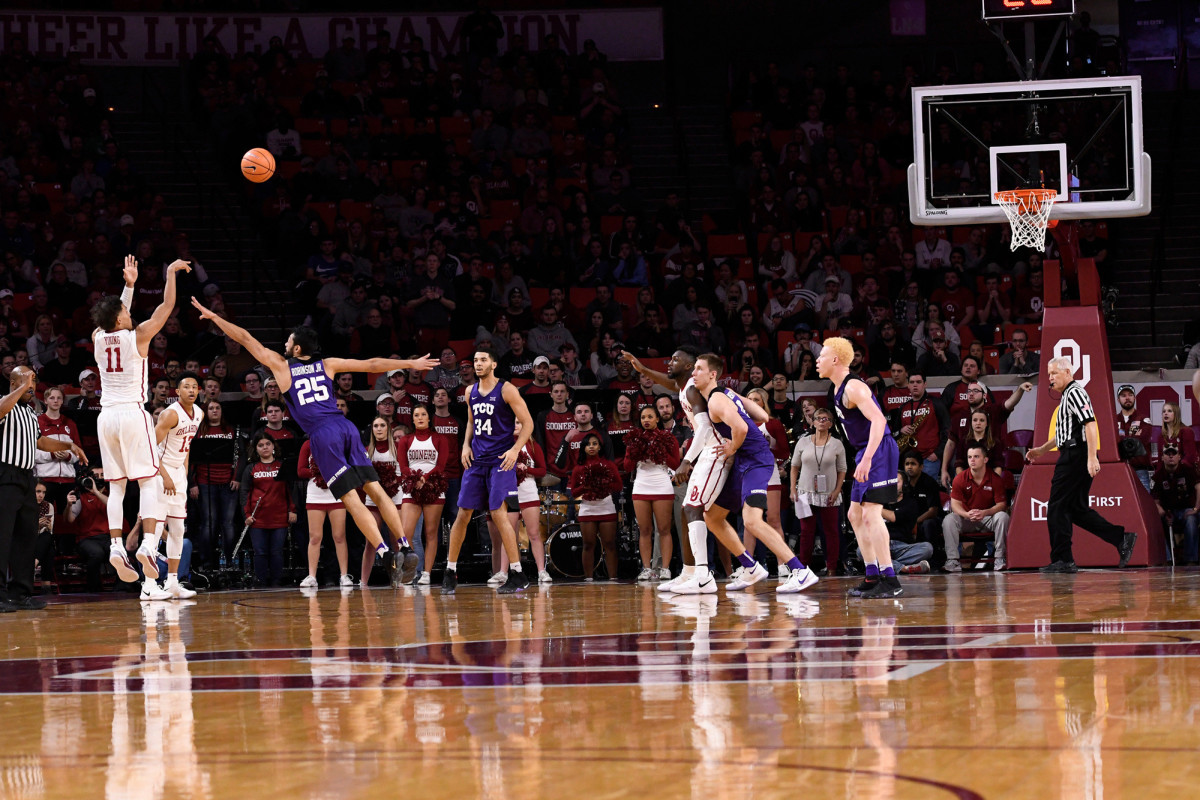
Herein lies one key to understanding Young. At times his audacity and skill might be hard to comprehend, but his confidence has been earned over the kind of countless, boring-to-describe hours of preparation that have earned him the right to think he can shoot it from wherever, because he already has more times than anyone could know. But surely even Young could not have had expected this kind of freshman season. "I knew my numbers would be there because of the way we play," Young says, referring to the freedom coach Lon Kruger gives his players, "but if we won, all this would come with it."
All this meaning the attendant hoopla surrounding him, a full-court press of coverage that harks back to the days of Jimmer or J.J. or Melo. The first week of January he'd appeared on two separate editions of SportsCenter in consecutive days; the afternoon after we spoke he would have a Slam Magazine cover shoot; ESPN was coming soon to film a College GameDay feature.
But he's used to it. He's had hundreds of thousands of Twitter and Instagram followers since high school, which helps explain the postgame security. Last year, as his college-decision announcement neared, it all got to be a bit much. He would show up to the movies only once the previews had started, and he stopped going to Thunder games to avoid fans interrogating him about his destination. Even on Oklahoma's preseason tour of New Zealand, local kids whipped out their phones when they recognized him. All of this is cool, but it's not completely new.
What about the comparisons to Curry, I ask. Are those ever a burden? "What do you mean by a burden?" he says. I suggest they might be hard to live up to. "No, I mean, I guess people expect me to play like Steph now every night," he says, amused. "But I just play my game. Who wouldn't want to be compared to a guy like Steph Curry?"
And the NBA stars shouting him out, is that ever surreal? It's fun, he says, but not that big a deal. When he was younger he might have freaked out some. "But it's starting to be a reality now," he says. "Maybe I could be playing against them. So I can't be too much of a fan."
In this way too his father prepared him. Rayford sought to demystify the NBA for Trae from a young age, using his friendships with various players and coaches to get his son into locker rooms and chat with the hoops stars whenever he could, as much to soak up advice as to give him a sense of purpose. Once Trae was making the rounds through the elite AAU circuit, he started to meet stars such as Kobe Bryant and Anthony Davis (who told him not to shave his eyebrows). As a boy he nearly wore a Chris Paul jersey to shreds; now, having connected through youth all-star camps, he and Paul speak regularly over FaceTime, often about everything but basketball. Kevin Durant sponsored his AAU team, MOKAN Elite, and sometimes KD's people would invite Trae to watch hoops and hang out at Durant's place in Oklahoma City. "He was just a normal dude," Young says.
So no, none of this is overwhelming, or even all that sudden. "I've been working to try to have it like this for a long time," Young says.
There are still ways that he's like any college kid. He takes classes, and in the fall his favorite was psychology, which he says taught him "mind tricks" for high-pressure situations. One involves closing your eyes and taking deep breaths before relaxing your shoulders and neutralizing the rest of your body. Two days earlier, he says, he had used it in a game against Texas Tech, during which he'd shot 1 for 12 in the first half. After halftime he did his mind trick at midcourt. He finished with 27 points.
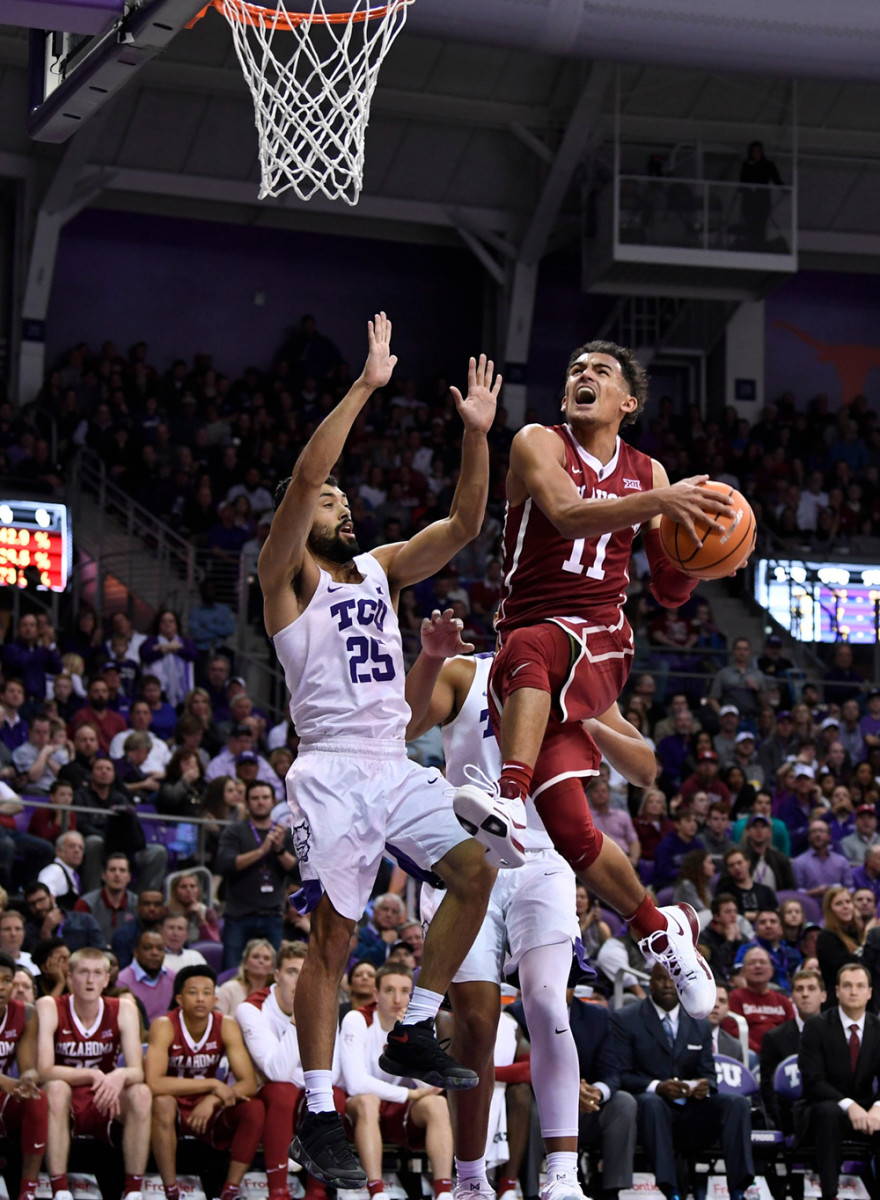
Clips of his plays loop once more on the laptop, a reel of spectacular highlights now wallpaper to stare at idly during conversation. I ask if his psych course covered imposter syndrome. "Imposter syndrome," he repeats, furrowing his brow. He shakes his head. I tell him it's when people worry that despite their accomplishments, they will be exposed as a fraud, as an imposter among their successful peers. And here, because Young is unceasingly polite, he tries to forge common ground by telling me he too is sometimes afraid of failing. No, I clarify, some people are scared of succeeding. "Scared of succeeding?" he says, looking bewildered, as if it's something that might be real but he just can't grasp, as if he's like the rest of us watching him play basketball.
The next morning Young and his teammates stand before an assembly in the gymnasium of Norman's Truman Primary School, which the Sooners visit regularly to perform community service; today's trip includes a bunch of games involving marshmallows. Later, during a Hula-Hoop contest featuring basketball players and second graders, Young's hoop drops limply to the floor a few times before he looks up to see a kid hardly moving his hips, his hoop rotating perfectly. Young stops trying and simply points in the kid's direction, game recognizing game.
Young is not eager to leave this town. He goes home to nap on his parents' couch. Candice still does his laundry. He enjoys attending his siblings' sporting events, impromptu lunches with Mom, late-night chats with Dad in an empty Noble Center after they've finished yet another private workout. He still gets his hair cut at Payneless Images. He still meets his family for 10 a.m. services at Victory Family Church.
But the timetable for departure has accelerated. One-and-done wasn't the plan, because not even the Youngs envisioned Trae playing his way into contention for a top three pick. The prospect of saying goodbye to Norman and heading off to some NBA city does not daunt him, however. "That's just me chasing my dreams," he says. When his time comes, he will be ready.
Why would he believe anything else? He's not playing like a normal freshman because he's spent years making sure he would not be a normal freshman; he's not handling this like a typical 19-year-old because there was no chance he'd turn out to be a typical 19-year-old. He's not a sudden sensation. He's nearly two decades in the making; we're all just surprised because we weren't with him in the gym, rolling our eyes at the dad and the broom.
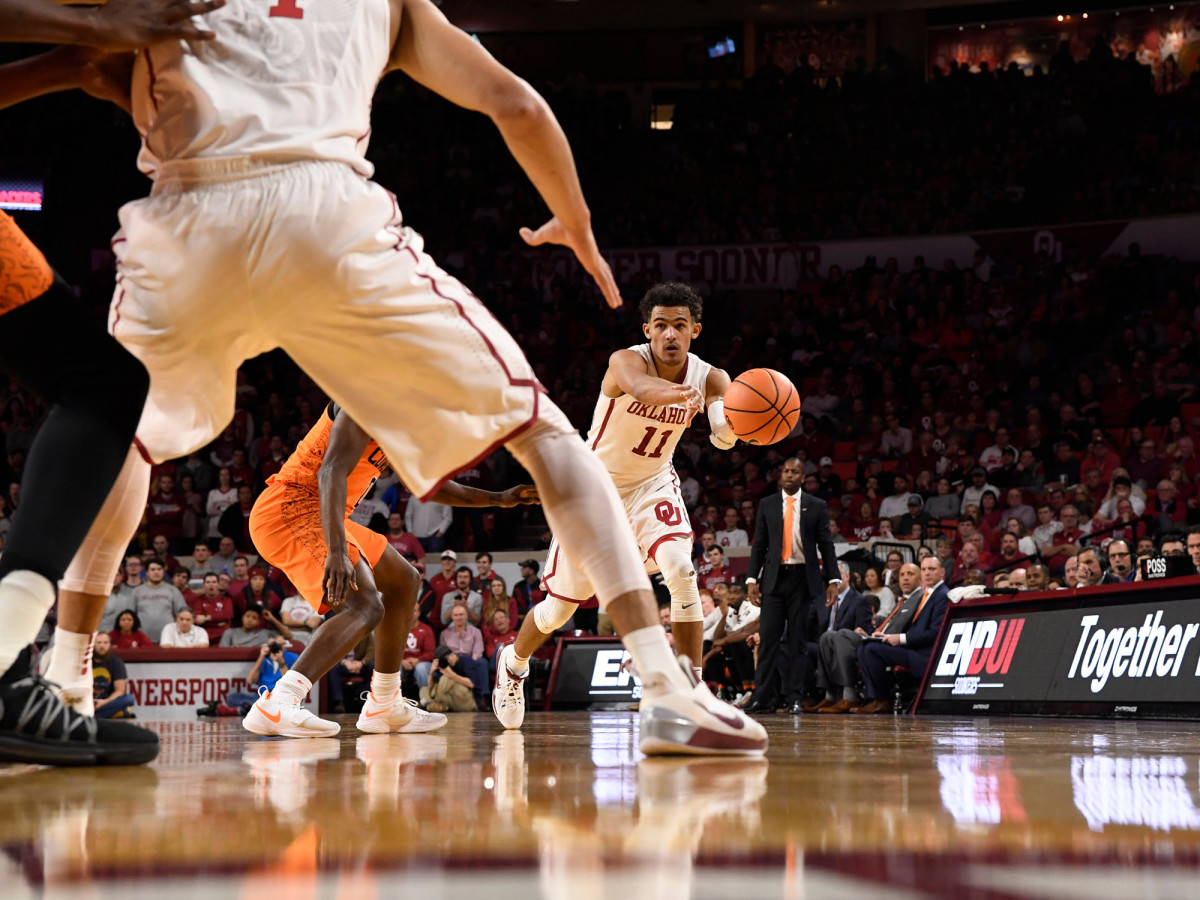
The day after the marshmallow contests I watch one of Young's games in person for the first time, a rematch with then No. 16 TCU. It's another dazzler: 43 points, including a second-half run of 16 straight, plus 11 rebounds and seven assists in an 102–97 overtime win. He takes 18 threes and makes 10, many of them launched with a staggeringly quick flick from daringly deep. Each shot is accompanied by an entire arena's anticipatory inhale. Whenever one rattles out, it's followed by the crowd's disappointed deflation—the surprise no longer the attempt, but the miss.
Seven minutes into the game Young scores his first points since he dribbled between his legs three times and drained a trey on the opening possession—yet another faraway bomb. The arena erupts; the Sooners now lead by nine, and the Trae Young Show has returned to its regularly scheduled programming. As he jogs backward down the court, Young ever so slightly shakes his head. And there in that fleeting moment is a feeling to which all of us relate.
